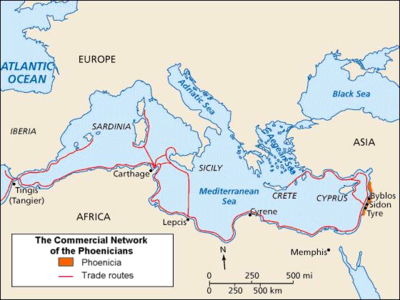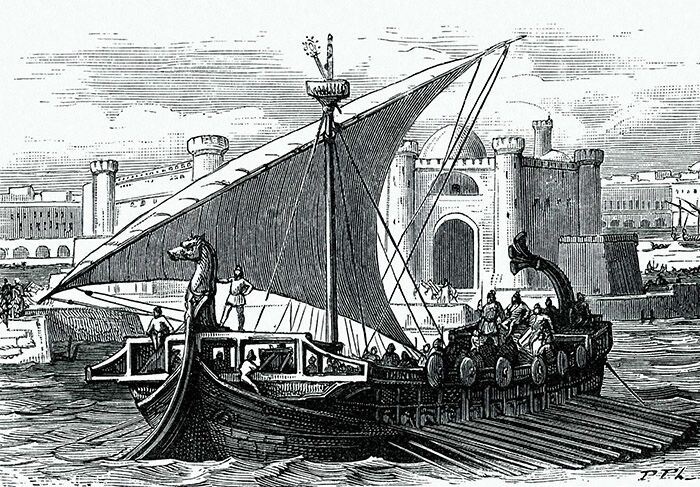A Phoenician Contribution That People Still Benefit From Today Was
The Phoenicians likely did not invent the alphabet. The Phoenicians were the greatest traders in ancient times.

Phoenician Civilization New World Encyclopedia
The Egyptians discovered papyrus and the reed pen so.

. The Phoenicians made a significant contribution to writing by developing the first alphabet. Influence of the Phoenicians. It took about 1200 of them to make a 14 g of a trim of a garment.
The people known to history as the Phoenicians occupied a narrow tract of land along the coast of modern Syria Lebanon and northern Israel. Two contributions that are still used in todays society are the Phoenician alphabet and the twelve-month calendar. March 6 2022 at 808 pm.
Nonetheless the Phoenicians were responsible for spreading the alphabet to other cultures living along the Mediterranean including to the Greeks. Some of the trading post in Cartage Cadiz Cyprus and Rhodes. The invention of the phonetic alphabet.
This empire was in fact one of the greatest producers of ancient books of its time. This invention lead to the first wheeled vehicles and lead to the further development of farm tools. The Phoenicians were renowned as excellent mariners and used their expertise to trade all across the Mediterranean.
The invention of the labyrinth. They became renowned as traders. That honor probably goes to Semitic speaking people living in Egypt.
Other countries either borrowed or modified their own alphabet based on the Phoenician alphabet. The alphabetic system of writing. The island city of Tyre and the city of Sidon were the most powerful states in Phoenicia with GebalByblos and Baalbek as the most important spiritualreligious centers.
At the heart of it all were a mysterious people. The Phoenicians were the greatest traders in ancient times had traded around the Mediterranean border. One of the most notable signs of their trade activity is the establishment of.
Per The Metropolitan Museum of Art the Phoenician people were most active around 1500 300 BCE and lived in the Levant region of the eastern Mediterranean. Our alphabet is based on theirs. The invention of the sail.
One of their accessible resource was glass makingThe Phoenicians did not invent glass. Phoenicia f ə ˈ n ɪ ʃ ə-ˈ n iː- was an ancient thalassocratic a state with primarily maritime realms civilization originating in the Levant region of the eastern Mediterranean primarily located in modern Lebanon. People wore purple garments or togas was considered royal.
Modern Phoenician studies were launched during the early 1960s by Sabatino Moscati and the Italian school. ³Their main role in the development of the Greek and other Mediterranean cultures was as intermediaries between Asia and Europe. The territory of the Phoenician city-states extended and shrank throughout their history and they possessed several enclaves such as Arwad and Tell Sukas modern Syria.
Despite little being known about them as very few of their inscriptions have survived their legacy has had an enormous impact on the world which is still felt today. What Phoenician contribution do we still benefit from today. It is a contribution from Phoenicians as todays alphabets have developed from it.
The three enduring commitments of the antiquated Phoenicians were The AlphabetsTrade And Commerce and Religion. Only wealthy people could afford it. The Phoenicians sailed all over the Mediterranean and set up many settlements on its shores most notably Carthage in North Africa.
But the most influence we feel today is their alphabet. The traded ivory cedar wood wine embroidered cloth wood carvings pottery and metal. Even today historians and archaeologists cant quite agree on who was a part of this diverse group.
By the seventies there was an emphasis on the Phoenician expansion. They are famed for their commercial and maritime prowess and are recognised as having. In the writings of Herodotus Phoenicia brought the alphabet over to Greece and this is the foundation of almost every western language that is still used to this day.
An open-work ivory panel of a human-headed sphinx c900-700 BC found at Fort Shalmaneser in northern Iraq. Crafts making was a big part of the Phoenicians because they able to use accessible resources. A Phoenician contribution that people still benefit from today was.
Purple or Tyrian Purple was first discovered by the Phoenicians. Black Africa is the origin of all Semitic tongues and even today there still exists many ethnic groups in Africa with semitic roots. Here are five important Phoenician contributions to Western society.
The Phoenician alphabet contains letters that we still use today but are just in different forms. While the Egyptians didnt discover the paper we use today papyrus was a huge step up from carving words into stone both in terms of ease of writing and being lighter to carry around. They had trading post around the Phoenician colonization.
The Purple dye came from a gastropod mollusks called Bolinus Brandaris. The Phoenicians were a people of Canaanite origins and the Canaanites just like the people people of ancient Egypt were black Africans. They were also known for their unique purple dye.
However a Phoenician glass maker invented the free-blowing technique. The Phoenicians were a great maritime people known for their mighty ships adorned with horses heads in honor of their god of the sea Yamm the brother of Mot the god of death. Phoenicia was a thalassocratic ancient Semitic-speaking Mediterranean civilization that emerged in the Levant particularly Lebanon in the west of the Fertile Crescent.
A phonecian contribution that people still benefit from today was the inventioin of the phonic alphabet Varnas the name given to the different groups of the original caste system came from a word that means. The introduction if Indo-Aryan language to Europe. I remeber I learned THIS in schooL.
The Phoenicians 1500 300 B C Essay The Metropolitan Museum Of Art Heilbrunn Timeline Of Art History

Constantine The African And The Qayrawani Doctors Contribution Of The Phoenicians Of North Africa To Latin Medicine In The Middle Ages And Renaissance Muslim Heritagemuslim Heritage
The Phoenicians 1500 300 B C Essay The Metropolitan Museum Of Art Heilbrunn Timeline Of Art History

Comments
Post a Comment